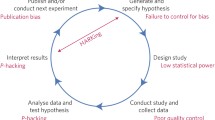Abstract
Currently, research is mostly organized in research projects intended to provide results within a limited period of time. Here, small teams of scientists erratically define single scientific studies, write a proposal, and send it to the refereeing board. In case of a funding, the study is carried out and the results are published. To optimize the research and reduce the respective costs and/or raise the outcome, multiple research projects should be organized within a comprehensive research program. A meta-model (paradigm) can help comprise (a) the representation of the state-of-the-art decision knowledge, (b) the adding of new research questions, (c) the performing of trials to answer these questions, and (d) the revision of the current model. It will be discussed how to structure studies within research programs and these within one super-program.
Similar content being viewed by others
References
Bertalanffy, L. v. (1950). General system theory. The British Journal for the Philosophy of Science, 1(2).
Bertalanffy L.v. (1974). General system theory: Foundations, development, applications. Penguin University Books, Harmondsworth, Middlessex
Booch G. and Rumbaugh J. et al. (1999). UML: The unified modeling language user guide. Addison Wesley, Reading, Mass.
Bray, T., Paoli, J., et al. (1998). Extensible Markup Language (XML), W3C Recommentations.
Eddy D.M. (1994). Clinical decision making: From theory to practice. Principles for making difficult decisions in difficult times. Jama 271(22): 1792–1798
Finkeissen E. (2002). Combining strategy and sub-models for the objectified communication of research programs. In: Magnani, L., Nersessian, N. and Pizzi, C. (eds) Logical and computational aspects of model-based reasoning (Vol. 25), pp 313–330. Kluwer Academic, Dordrecht
Finkeissen E. and Bohret S. et al. (2002a). AIDA: Web agents to support dental treatment planning. International Journal of Computerized Dentistry 5(2–3): 133–138
Finkeissen, E., Fuchs, H., et al. (2002b). medrapid—Aktuelles medizinisches Fachwissen auf Knopfdruck. Telemedizinführer Deutschland 2003, pp. 154–157.
Finkeissen E. and Weber R. et al. (2002c). AIDA—experiences in compensating the mutual weaknesses of knowledge-based and object-oriented development in a complex dental planning domain. Methods of Information in Medicine 41(2): 168–176
Kuhn T.S. (1979). The structure of scientific revolutions. Chicago Press, Chicago
Lakatos I. (1974). Falsifikation und die Methodologie wissenschaftlicher Forschungsprogramme. In: Lakatos, I. and Musgrave, A. (eds) Kritik und Erkenntnisfortschritt, pp 89–189. Vieweg, Wiesbaden Braunschweig
Quatrani T. (1998). Visual modeling with rational rose and UML. Addison Wesley, Harlow, England
Stachowiak H. (1973). Allgemeine Modelltheorie. Springer, Wien
Author information
Authors and Affiliations
Corresponding author
Rights and permissions
About this article
Cite this article
Finkeissen, E. Steps from Erratic Projects towards Structured Programs in Research. Found Sci 13, 143–148 (2008). https://doi.org/10.1007/s10699-008-9123-1
Published:
Issue Date:
DOI: https://doi.org/10.1007/s10699-008-9123-1




